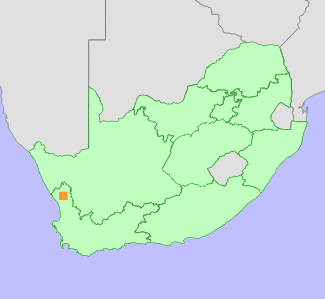|
Scientific Name | Tylecodon nolteei Lavranos |
Higher Classification | Dicotyledons |
Family | CRASSULACEAE |
National Status |
Status and Criteria | Endangered B1ab(v)+2ab(v); C2a(i) |
Assessment Date | 2022/08/01 |
Assessor(s) | E.J. van Jaarsveld, D. Raimondo, P.G. Desmet & N.N. Mhlongo |
Justification | This succulent is endemic to a small area of Namaqualand in South Africa's Northern Cape Province, it has an extent of occurrence (EOO) of 204 km² and an area of occupancy (AOO) of 24 km². It is known from between three and five locations and is experiencing ongoing decline in the number of mature individuals as a result of illegal harvesting to supply the specialist succulent ornamental plant trade. It has a small population size of less than 2000 mature individuals. Monitoring data indicate that most subpopulations are small consisting of fewer than 50 plants, with the largest recorded subpopulation having 150 mature individuals. It therefore qualifies to be listed as Endangered under criteria B and C. |
Distribution |
Endemism | South African endemic |
Provincial distribution | Western Cape |
Range | This dwarf succulent species is a South African endemic which occurs near Nuwerus in the Northern Cape. |
Habitat and Ecology |
Major system | Terrestrial |
Major habitats | Knersvlakte Quartz Vygieveld, Southern Namaqualand Quartzite Klipkoppe Shrubland |
Description | Plants of this species are typically found in rock crevices in sandstone, quartzite or shale. |
Threats |
| This species is threatened by the illegal collection of wild plants to supply the succulent trade. This is due to its attractive features and the fact that certain subpopulations are easily accessible. It may also potentially be impacted by changes in climate as the region where it grows is experiencing ongoing aridification with a severe drought experienced between 2015 and 2021. |
Population |
It is known from five locations in South Africa. The population is declining due to the illegal collection of individuals to supply the horticultural trade. Field monitoring over the past 10 years indicates that most subpopulations are small, numbering fewer than 50 plants with the largest recorded subpopulation having only 150 mature individuals. The overall population is estimated to be smaller than 2000 individuals.
|
Population trend | Decreasing |
Conservation |
| It occurs in a protected area and is in ex situ collections (BGCI 2022). |
Assessment History |
Taxon assessed |
Status and Criteria |
Citation/Red List version | | Tylecodon nolteei Lavranos | VU D2 | Raimondo et al. (2009) | |
Bibliography |
Raimondo, D., von Staden, L., Foden, W., Victor, J.E., Helme, N.A., Turner, R.C., Kamundi, D.A. and Manyama, P.A. 2009. Red List of South African Plants. Strelitzia 25. South African National Biodiversity Institute, Pretoria.
Snijman, D.A. 2013. Plants of the Greater Cape Floristic Region 2: The extra Cape flora. Strelitzia 30. South African National Biodiversity Institute, Pretoria.
|
Citation |
| van Jaarsveld, E.J., Raimondo, D., Desmet, P.G. & Mhlongo, N.N. 2022. Tylecodon nolteei Lavranos. National Assessment: Red List of South African Plants version 2024.1. Accessed on 2025/12/08 |
 Comment on this assessment
Comment on this assessment


